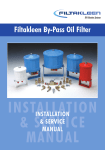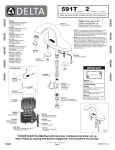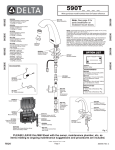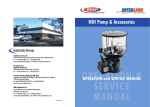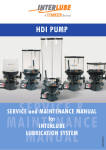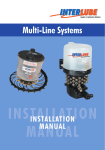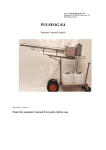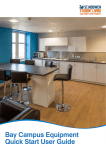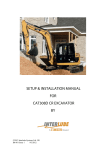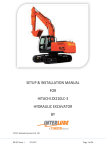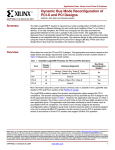Download INSTALLATION & SERVICE MANUAL
Transcript
Oil Filtration Systems Filtakleen By-Pass Oil Filter INSTALLATION INSTALLATION & SERVICE & SERVICE MANUAL MANUAL xx INTRODUCTION The Filtakleen By-Pass oil Filter is an ultra-fine 1 micron Bypass filtration system suitable for use with a wide range of equipment. It provides the best possible filtration protection against system wear, oil degradation, rust and corrosion. Working in conjunction with the equipments full flow filter, the Filtakleen By-Pass Filter removes any particles in the oil likely to cause system damage. The Filtakleen Bypass Filter typically filters all the oil in the system several times an hour, so the system continuously receives analytically clean oil. What are the benefits of the Filtakleen Bypass Filtration? UK Headquarters: Interlube Systems Ltd St Modwen Road, Parkway Industrial Estate, Plymouth, Devon, England PL6 8LH Tel: +44 (0)1752 676000 Fax: +44 (0)1752 676001 e-mail: [email protected] Web Site: www.interlubesystems.com USA Headquarters: Interlube Systems Inc 4696 Wadsworth Road, Dayton, Ohio, 45414, USA Tel: + 1 937 276 4507 Fax: + 1 937 276 4518 e-mail: [email protected] • An extension of Oil Drain and Filter Change Intervals • An improvment of Oil cooling • An increase of filtration quality and so an extension of the engine life • An increase in the fluid system capacity • An efficiencient removal of small particle and soot • Reduced cost of oil and full flow filters • Less wear (up to 90%) • 1-Micron filtration • 100% water removal SYSTEM DESCRIPTION The By-Pass filter is designed to be used in conjunction with the main in line filter. The system continuously filters a percentage of the oil, typically 10%, in the circuit which means it is able to provides additional filtration to a much finer tolerance than the in-line filter. This greatly prolongs the life of both the oil and the main filter itself. The filter housing is manufactured as a one piece aluminium anodised body which is powder coated, making it suitable for all environments, and offering total durability. The lid is secured by a single high tensile bolt which makes lid removal and filter changing quick and easy. The lid houses an quad ring seal giving completely leak proof sealing. The filter cartridge is made from a cellulose fibre based tissue of pure pulp, around a cardboard core. The cartridge is housed in a nylon stocking with an impressed brass ring to facilitate cartridge removal. The filter housing is fitted using an adjustable mounting bracket, which offers the installer a wide range of filter positions and fixing points. The filter is capable of filtering all types of oils with a viscosity range of 9-220cst. It is also suitable for use with other mediums such as bio fuels and dielectric fluid Single bolt high tensile steel, allows for easy cartridge change Heavy duty lid seal Oil flow in filter Powder coated 1 piece aluminum body Bracket fixing allows for flexible position Oil inlet Outlet Filter Cartridge Filter Core Universal mounting bracket Operation Oil enters the filter via the inlet point and passes up through the core of the filter. The oil then percolates slowly down through the filter medium, through the outlet, and is returned to the system. Systems for hydraulic oils will have a pressure reducing manifold fitted to the bottom of the filter body. This reduces to reduce down the high pressures of a hydraulic system to the operating pressure of the filter. Engine oil systems have no need for the manifold as they operate at much lower pressures. The standard operating pressure of the filter is approx 5 bar. The manifold incorporates a pressure relief valve which is factory set at 65psi / 4.45bar. The manifold has a test point for the attachment of fluid monitoring equipment. A pressure gauge is available as an option. 3 SYSTEM COMPONENTS The correct size filter for the application should be confirmed by referring to the application table on page10. The filter kit comprises a filter assembly including mounting bracket, filter cartridge, and a range of fittings as listed below. The system is designed to be installed with ?” inlet hose, and 3/8” outlet hose, and fittings to suit this size hose, plus connections into the filter are provided. With hydraulic systems a ball valve and pressure reducing manifold are included. Maxi Duty Hydraulic Kit Bantam Engine Kit The following fittings are supplied as part of a kit Engine Kit Hydraulic Kit Qty 17-17067A Ball Valve 1/4 bsp 1 17-17070 R/U 3/8 Swept Elbow 1 17-17055 R/U RIT 3/8 Ferrule 2 17-17092 R/U 1/4 Swept Elbow 1 17-17054 R/U R2T 1/4 Insert 1 17-17052 R/U 1/4 Insert 1 17-17072 R/U 3/8 Insert 1 17-17060 R/U 3/8 90 Degree Elbow 1 17-17069 1/4 90 Degree Swivel Adaptor 1 17-17091 R/U 1/4 90 Degree Compact Elbow 1 17-17016A Manifold block 1 17-17092 17-17052 17-17076 17-17074T 17-17056 R/U 1/4 Swept Elbow R/U 1/4 Insert 1/4 BSP 1/4 BSP Male Adaptor 1/8 BSP 1/4 BSP Male Adaptor R/U RIT 1/4 Ferrile Qty 2 2 2 1 4 Hose and tubing do not come with the kit, and can be ordered separately, please refer to page 11 Please note that additional fittings will be required for installation, the size and type of which will vary according to the equipment on which the system is to be fitted. 4 SYSTEM INSTALLATION Entry Points In principle the take off point should always be on the main system feed, after the pump. It can be either before or after the main in-line filter. Engine oil Systems Usually located in the oil gallery, many engines have unused plugs here, or on the oil filter housing. Another option is to remove the oil pressure sensor and refit a T-piece adaptor. The turbo lubrication is usually fed via a banjo-bolt, which can be replaced by one with an external inlet. A mechanical fuel pump is fitted with a banjo-bolt lubrication line too, which can also be replaced by one with an external inlet. And if necessary, the compressor lubrication can be used. Each individual situation will show which is preferable. In engine oil the temperature can be as high as 120oC. Hoses with single steel braiding and temp spec of 150oC continuous should be used. Hydraulic oil temp is normally not more than 80oC so the emphasis here is pressure. Modern construction equipment uses up to 450 bar pump pressure, which can be handled by the Safety Manifold. But the hose must be 2 steel inlays with working pressure of at least 650 bars, to compensate for peak pressure. Mounting the units Hydraulic Oil Systems Preferably the units should be mounted with the lid above the liquid level in the hydraulic tank or the motor oil sump. This because in the return lines there are non-return valves and the liquid could overflow the bowl when opening the lid for cartridge change. Also the units should be easily accessible from the front, again for easy change of cartridge. And lastly, there must be enough space above the unit to accommodate the cartridge change. The pressure should be taken from the main pump circuit, as this is the system which will have the most working hours, (if more than one pump is fitted). The units can be fitted to high pressure systems, up to a maximum of 9000 psi. Use of this circuit maximises the time available for effective filtration. Typically this pump has overcapacity, so that the oil stream taken to the by-pass filter will not influence the performance of the system. Never take the pressure from a servo or pilot circuit, because one cannot predict if certain functions of the system will be adversely influenced. This may even be dangerous. Hoses must be rated for the operating pressure of the equipment. Brackets should be bolted to the frame of the equipment. Welding is an option, but some modern equipment has sophisticated computers, which must be unplugged completely, before welding starts. Engine system fitment Hydraulic system fitment RETURN By Pass Filter TANK MANIFOLD IN OUT BALL VALVE Full Flow Filter FLOW MAIN PUMP ENGINE Returns to Sump Sump Connection into main line should be after pump and can be before or after in-line filter INLINE FILTER 5 Pressure Reducing Manifold The relief valve is factory set at 65psi as this is the most effective setting for filtration. However in the event of adjustment being necessary, connect a pressure gauge to the test point. Turn clockwise to increase pressure setting, and anti-clockwise to reduce. In the majority of cases, on the pressure side of the main pump, there is a pressure test nipple, which can be taken out and refitted with a T-piece. If not, this nipple is situated on the first valve block in the pump pressure line. Sometimes the pump or the valve block has loose plugs, which can be replaced by an adaptor. Pressure adjustment screw PIC 1 Ball valve Take off point In-line filter If none of these exist somewhere in the main pressure line, a fitting such as a T- piece or elbow can be used (e.g. Pic 1). it should be taken off and drilled and threaded to take a suitable fitting. The ball valve can be positioned anywhere in the line from the take off point up to the filter (Pic 2). Outlet Filter Ball valve PIC 2 When working on a hydraulic system it is preferential to have the tank air pressure relieved or even better if a vacuum pump is placed on the tank filler opening to maintain under pressure in the tank and system while working. This helps to prevent awkward oil spills. 6 Inlet Adjustable pressure relief valve Test point Return points Post Installation: In general there must not be any backpressure in the return line such as orifices, partial pressures in pilot systems, etc. The outlet of the by-pass filter should be zero pressure. Once the installation is complete, check that all connections are secure. Confirm that the inlet (pressure) and outlet (return) hoses are connected to the correct ports in the filter housing, as failing to do this will result in inefficient filtering and oil to leak from the lid of the filter housing. Make sure all pipes are secured tightly i.e. with tie wraps, especially near the inlet and outlet adaptors. Run the engine or equipment making sure that there are no oil leaks and that oil is passing through the filter. Engine oil systems Return points can be found in unused plugs on the sump (if this is below liquid level use a vacuum pump on the oil filling point). Alternatives are: •the return of the turbo lubrication to the block is sometimes a banjobolt, which can be replaced. •on the sump rim is a plug for a second sounding rod on the opposite side of the block. •the oil-filling pipe can be removed, drilled and threaded to fit an adaptor. •the valve cover can be removed, drilled and fitted with an adaptor. See that the adaptor outlet is above the camshaft rod and not over the valve stem. This results in excessive oil consumption. Hydraulic oil systems Return points can be found on the tank return manifold in unused plugs. Alternatives are: •an extra coupling can be drilled, threaded and fitted with an adaptor, can interrupt leakage lines. •lines such as knee bends or bulkheads feeds be removed, drilled and threaded. Remember this is all low pressure, where some hydraulic seal compound is enough to prevent oil spill. 7 CHANGING THE FILTER CARTRIDGE On Engine systems engine should be switched off On hydraulic systems turn ball valve to off position (pic 1). The machine need not be switched off. Undo lid bolt, allowing air to enter system. (pic 2) If the units are mounted above tank level, the bowl will empty back into the system; this will take a few minutes. Withdraw old cartridge using brass ring (pic 3). Note: To help prevent oil spill, the bag from the new replacement cartridge can be slid over filter pot and cartridge withdrawn into it. Insert new filter element without cleaning inside the bowl and push in firmly (pic 4/5). Replace lid seal with the new one provided, (pic 6) and tighten bolt to approx 20lbs/ft. Open ball valve or restart engine and check system for leaks. Lid bolt PIC 1 Lid bolt washer Lid bolt O ring Lid Lid seal PIC 2 PIC 3 Filter cartridge PIC 4 Filter body PIC 5 Heavy Duty PIC 6 8 CARTRIDGE CHANGE GUIDELINES Filter element life is dependant on the original oil condition. Figures given are for guidance. If the oil is very dirty, or a higher level of cleanliness is required, more element changes will be needed. However, the Filtakleen filter will always purify the oil to a safe re-usable condition, given sufficient element changes. Even totally emulsified oil will be reclaimed and purified to a better than new condition usually within 4 element changes. Guidance for cartridge changes ENGINES Filtakleen filter change Bantam 3000m/5000km 500 hours 3 months 2000 hours/annual 3750m/5000km 500 hours 3 months 2000 hours/annual 9300m/15000km 1250 hours 3 months 100000m/160000km/annual 15600m/25000km 1500 hours 3 months 100000m/160000km/annual Light Heavy Maxi Main filter change Oil Change HYDRAULICS Heavy 500 hours / 3 months 2000 hours/annual 10000 hours/5 years Maxi 500 hours / 3 months 2000 hours/annual 10000 hours/5 years Where alternate figures are shown the earliest reached should be used ENGINES Change Filtakleen cartridge at every service interval Change standard oil and filter every 12 months minimum HYDRAULICS Change FK cartridge at every maintenance interval Change standard full flow filters annually 9 SPECIFICATION Application Engines Hydraulics Product Bantam Light Heavy Maxi Heavy Maxi Kit FF368 FF668 FF878 FF988 FFHY778 FFMY788 Filter colour White Red Blue Blue Blue Blue 14 litre 36 litre 72 litre 900 litre 2000 litre Sump/Tank capacity 8 litre Flow rate 1.5 l/min 3.0 l/min 4.5 l/min 6 l/min 4.5 l/min 6 l/min Filter Body Aluminium Aluminium Aluminium Aluminium Aluminium Aluminium Weight (exc fittings) 1.5 kg 1.8 kg 2.8 kg 3.9 kg 3.3 kgs 4.4 kg Inlet connection 1/4 bsp 1/4 bsp 1/4 bsp 1/4 bsp 1/4 bsp 1/4 bsp Outlet connection 1/4 bsp 1/4 bsp 1/4 bsp 1/4 bsp 3/8 bsp 3/8 bsp Inlet Pressure 4.45 bar (65psi) 4.45 bar (65psi) 4.45 bar (65psi) 4.45 bar (65psi) 350 bar (5000psi) 350 bar(5000psi) Internal pressure 4.45 bar (65psi) 4.45 bar (65psi) 4.45 bar (65psi) 4.45 bar (65psi) 4.45 bar (65psi) 4.45 bar (65psi) Max Oil temp * 79ºC 79ºC 79ºC 79ºC 79ºC 79ºC Viscosity range 9-220cST 9-220cST 9-220cST 9-220cST 9-220cST 9-220cST Cartridges PART No C58 C68 HYC78 MYC88 HYC78 MYC88 Height 78mm 114mm 114mm 114mm 114mm 114mm 190mm Diameter 102mm 102mm 145mm 190mm 145mm Filter Length 102m 114m 272M 460m 272m Surface area 80,000 sq cm 130,000 sq cm 490,000 sq cm 524,000 sq cm 490,000 sq cm 524,000 sq cm Weight 184g 300g 630g 1060g 630g 1060g 460m *Recomended maximum operating temperature. Filter can operate at higher temperatures but filter life may be affected A SPARES FF368 Bantam Duty Description Part number Cartridge Lid Lid Seal Lid Bolt Lid Bolt Lid Bolt O Ring Dowty Seal C58-1717058 17-17008 17-17046 17-17025 17-17051 17-17045 25131-003 B C Dimensions (mm) A B C Bantam 115 200 88 above sizes are approximate 10 Light 115 240 88 Heavy 166 275 105 Maxi 213 297 127 SPARES continued FF668 Light Duty Description Cartridge Lid Lid Seal Lid Bolt Lid Bolt Washer Lid Bolt O Ring Dowty Seal Part number C68-1717068 17-17005 17-17046 17-17024 17-17051 17-17045 25131-003 FF878 / FFHY778 Heavy Duty Description Cartridge Lid Lid Seal Lid Bolt Lid Bolt Washer Lid Bolt O Ring Part number HYC78-1717078 17-17001 17-17047 17-17023 17-17051 17-17045 FF988/FFMY778 Maxi Duty Description Cartridge Lid Lid Seal Lid Bolt Lid Bolt Washer Lid Bolt O Ring Part number MYC88-1717088 17-17002 17-17048 17-17023 17-17051 17-17045 Filter Fittings Description 1/4 x 1/4 bsp male 1/4 x 1/8 bsp male Part number 17-17076 17-17074T Hydraulic Systems Parts Description Manifold Block 1/8 x 1/4 bsp restrictor inlet adaptor 1/8 x 3/8 bsp outlet adaptor 1/8 Dowty Seal Ball Valve 1/4" R1 Hose 1/4" R2 Hose 3/8" R1 Hose Part number MYC78-1717088 17-17084 17-17077 14-20685 17-17067A 17-17059 17-17058 17-17057 11 Oil Filtration Systems Interlube Systems Ltd St Modwen Road, Parkway Industrial Estate, Plymouth, Devon, England PL6 8LH Tel: +44 (0)1752 676000 Fax: +44 (0)1752 676001 e-mail: [email protected] Web Site: www.interlubesystems.com USA Headquarters: Interlube Systems Inc Distributed by 4696 Wadsworth Road, Dayton, Ohio, 45414, USA Tel: +1 (937) 276 4507 Fax: +1 (937) 276 4518 Filtakleen Inc 514 West 8360 South, Sandy, UT, 84070, USA Tel: +1 (801) 233 9185 Fax: +1 (801) 233 2876 Toll Free 1-877-464-5728 www.interlubesystems.com












